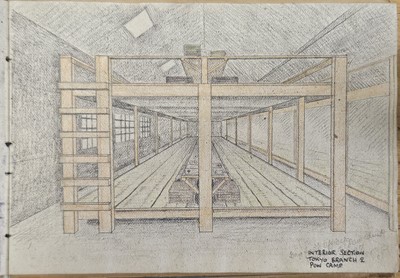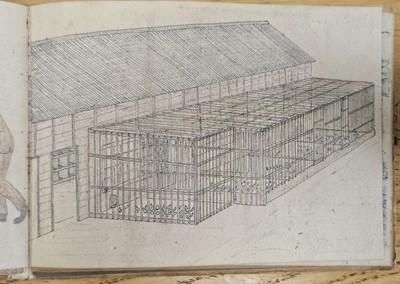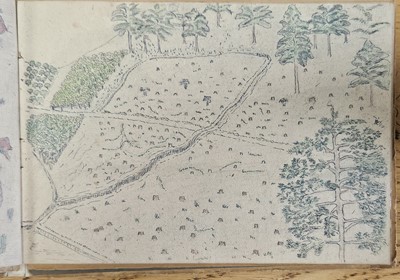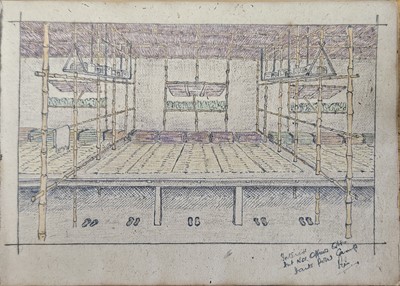Ending 20th Feb, 2024 16:00
Timed Militaria, Maritime and Naval Auction
Rare Second World War sketchbook by POW 2nd/Lt Arkless Lockey
Second World War – 2nd Lt. Arkless Lockey, Prisoner of War of Japan. An emotive sketchbook compiled after being taken prisoner at the Fall of Singapore and subsequently held in the Prisoner of War camps Changi in Singapore, Heito in Taiwan and Tokyo Branch 2 and Zentsuji in Japan, circa 1942-1945. 33 detailed sketches, some covering two pages, plus 11 separate loose pictures, including portraits of other prisoners, album 20.5cm x 15cm. This is a rare album which was produced at great personal risk, given that prisoners were forbidden from creating any documentation and subject to severe punishment if found.
Sketches comprising: scenes at Heito (titled 'Haito') - including P.O.W.s loading stones, exterior and interiors of Hut. No. 1 Officer's quarters, general camp views, soldiers exercising, straw rope and shoe making.
Tokyo Branch 2 - the exterior and interior of the camp, 'Rice Fatigue' (prisoners hauling a cart).
Prisoner of War transport ship - Singapore to Taiwan - 'P.O.W. class'.
Changi - Royal Engineer's kitchen.
Zentsuji - Room No. 3, Library, Corner of Galley, Birds-eye view of the camp.
General untitled sketches include Japanese prison guards and locals riding a buffalo, soldiers overlooking a pigpen, caged areas, manual labour and a poignant black and white drawing of a 'Last Post' trumpeter on the final page.
The portrait sketches are of fellow American and British prisoners at Zentsjuji, dated January 1944 and identified by name. Examples include 'Frank Burwell' (BURWELL, Frank H. Jnr., 1st Lt., Infantry, U.S.A.); 'Stan Gladys' (GLADYS, Stanley J., 1st Lt., U.S.A., QMC); 'John Fisher' (FISHER, John W., 1st Lt., U.S.A., Infantry); 'Jeff Caldicott' (CALDICOTT, G. H., Lt., Singapore); 'Jim' Leggatt' (LEGGETT, James L. Jnr., Lt., USAAC, Engineer); 'Padre Godfrey' (GODFREY, Rupert C. R., Chaplain, R.A., Java); 'Gill Warner' (possibly WARNER, William S., 1st Lt., USAAC) and 'Chris Power' (POWER, C., F/O., R.A.F. Ireland).
Notes: Second Lieutenant Arkless Lockey [227089] Royal Engineers served with III Corps. At the time of his capture in the Fall of Singapore, he worked for the Deputy Assistant Director of Transportation. Based on the single sketch at Changi, he was likely held there briefly before he was transferred to Heito in August 1942, presumably as part of the large contingent of British and Allied P.O.W.s to arrive at Heito camp late that month. The main slave labour task in this camp was to pick rocks and stones from a vast area of an old dried river bottom near the camp to make the land ready to plant sugar cane. Camp Commandant, 1st Lieutenant Tamaki, was known for being sadistic and caring little for the welfare of the prisoners. He boasted of aiming to 'fill the cemetery', which he did (132 men died at Heito, the highest in-camp death rate for camps in Taiwan).
'Tokyo Branch 2' was a Dispatch Camp where the primary labour was shipyard construction. Based in Yokohama Baseball Stadium, it was renamed 'Tokyo Branch 3' on 1st August 1943. By that time, Lockey had likely transferred to Zentsuji camp in southern Japan, presumably until the end of hostilities. Despite being one of the few camps designed to hold prisoners (previously used in this capacity during the Russo-Japanese War in 1907 and the Sino-Japanese War in 1937) and used as a 'show' camp for propaganda purposes, conditions at Zentsjuji were still deplorable and overcrowded.
Heckling and depriving prisoners of food or medicine was reportedly a regular occurrence at the camp, which also acted as the headquarters for several work camps in the area. Access to food ranged from fair during the early months of occupancy to starvation levels in July 1944. The rice served contained weevils and worms, and the rarely offered meat rations ranged from fresh to rotten. No hospital existed on the site, but a side room with six bunks was reserved for medical cases, though the unfortunate occupants would only receive half rations.
The barracks consisted of two two-story buildings, both former warehouses, with half of one building dedicated to the guards. These were unheated after 1943 and poorly insulated. Each barracks was divided into rooms of 32 men, with four windows and only two light bulbs. These quarters were all infested with bed bugs, lice and fleas. Hot baths were available twice a month during winter, but only cold baths were permitted during the summer. It is a testament to the skills of the American officer working as the leading physician that he completed 24 serious operations without a single loss of a patient, with spinal novocaine being the only anaesthetic available. Clothing provisions were generally adequate, but more socks and gloves were always sought after, and the prisoners, in their malnourished states, could not keep warm despite being heavily clothed.
Workdays primarily consisted of loading and unloading freight or cargo vessels, though some enlisted men were assigned to camp detail. Hours were long, often 6 am - 7 pm, with three 'rest days' per month, taken up by other enforced work around the camp. Unlike the enlisted men, officers received fewer rations but were not forced to work outside in the rain or snow. The camp was liberated on 12th September 1945, and Lockey was reported as no longer a prisoner of war by 26th September 1945.
Arkless Lockey was born in 1901 in Durham. Post-war, he settled briefly in Malaya and Hong Kong with his wife, Marjory Tinto (b.1914), whilst working as a Railway Officer before returning to the U.K., where he died at 80.
Sold for £1,650



































